Zinc (Zn)
Zinc exits naturally in rocks. The amount of zinc present in the soil depends on the parent materials of that soil. Sandy and highly leached acid soils generally have low plant available Zinc. Mineral soils with low soil organic matter also exhibit Zinc deficiency. In contrast, soils originating from igneous rocks are higher in zinc. Plants take up Zinc as the divalent ionic form (Zn2+) and chelated-zinc for optimum growth and maximum yield.
Importance of Zinc in Plant Growth
The Zinc is one of the essential micronutrients require for optimum crop growth and deficiency of Zn, cause varies adverse effect on growth and yield of crops. The Zn deficiency is becoming more critical more than 40 per cent yield losses can have major economical impact on the farmer due to reduce income.
Role of Zinc in the Crop:
- Zinc in involved in formation of Chlorophyll and carbohydrate.
- Zinc present in several dehydrogenises, proteinese and peptidase enzymes.
- Promote growth hormones (auxin) and starch formation.
- Zn plays very important role for grain formation and nutrition.
- Help in biosynthesis of cytochrome: a pigment and maintain plasma membrane integrity and synthesis of leaf cuticle.
Crops that respond to zinc
Sufficiency levels of Zinc for major agronomic crops, vegetable, and fruits grow in Minnesota
Source: https://www.google.co.in/search?hl=en&site
Zinc Deficiency in Crop:
Zinc deficiency is probably the most common micronutrient deficiency in crops worldwide, resulting in substantial losses in crop yields and human nutritional health problems. Deficiency in Zinc might result in significant reduction in crop yields and quality. In fact, yield can even be reduced by over 20% before any visual symptoms of the deficiency occur! The cost to the farmer, associated with loss of production, is by far higher than the cost of testing the soil and plant tissue and applying Zinc fertilizers. The mobility of Zinc in plants varies, depending on its availability in the soil or growing media. When Zinc availability is adequate, it is easily translocated from older to younger leaves, while when Zinc is deficient, movement of Zinc from older leaves to younger ones is delayed. Therefore, zinc deficiency will initially appear in middle leaves.
Symptoms of Zinc deficiency include following symptoms:
- Stunting- reduced height
- Interveinal chlorosis
- Brown spots on upper leaves
- Distorted leaves
As mentioned above, the visual symptoms usually appear in severely affected plants. When the deficiency is marginal, crop yields can be reduced by 20% or more without any visible symptoms.
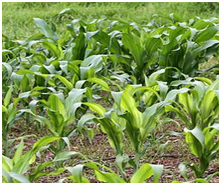
Zea mays

Triticum
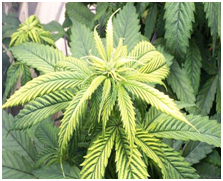
Cannabis sativa
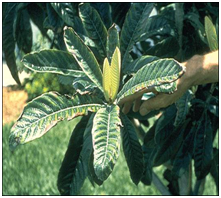
Eriobotrya japonica
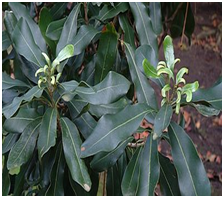
Macadamia integrifolia
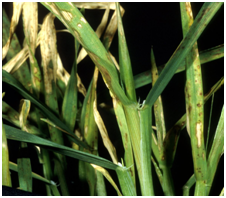
Hordeum vulgare
In order to identify a zinc-deficient soil, the soil and the plant should be tested and diagnosed. Without such tests, the soil might remain deficient in zinc for many years, without the farmer identifying the hidden deficiency, as visual symptoms may not occur. Zinc deficiency is common in many crops and on a wide range of soil types. It affects the main cereal crops: rice, wheat and maize as well as different fruit crops, vegetables and other types of crops.
Source: www.smart-fertilize
Soil Conditions that can result in Zinc deficiency include:
- Low total zinc level in the soil ( avaiable +unavaiable zinc)
- Low organic matter content or too high organic matter content (e.g peat soil)
- High soil PH
- Calcareous soils or limed soils
- Low soil temperature
- Anaerobic , waterlogged conditions
- High phoshorus level in the soil
Source: articles/zinc-in-plants
Soil conditions and the need for Zinc fertilizers:
Research at the University of Minnesota as well as other universities has identified soil conditions where a response to Zn fertilizers might be expected. These conditions are:
Soil Temperature : Cool soil temperatures in early spring can intensify the need for Zn. When soils are cold, the organic matter does not decompose and Zn is not released and available for crop growth.
Soil Texture : In Minnesota, most of the response to Zn in a fertilizer program will take place on fine-textured soils. Recent research on sandy soils indicates a response to Zn can occur when high yields are grown on sandy soils with a low organic matter content. The measured response to Zn fertilization in these situations has been small and has not occurred every year.
Topsoil Removal : The probability of a response to Zn fertilization increases where topsoil has been removed or eroded away. When soils are eroded, the amount of free calcium carbonate on the soil surface increases. The probability of the need for Zn in a fertilizer program increases as the percentage of free calcium carbonate increases.
Previous Crop : The probability of a response to Zn fertilization increases if either corn or dry edible beans follows a crop of sugar beets.
Phosphorus Levels : There is a known relationship between phosphorus (P) and Zn in soils. Excessive applications of phosphate fertilizers have caused a Zn deficiency in corn and reduced yields.
Source: agriculture/nutrient-management
Diagnosing Zinc Disorders:
Visual observation can be a quick diagnostic tool to identify zinc deficiencies. However, it requires knowledge and expertise, as symptoms may be confusing. In addition, once visual symptoms appear, yield loss has already occurred. Regular soil or plant testing is the best practice to determine if zinc application is required and to ensure that zinc does not accumulate in the soil to undesirable high levels. DTPA-extraction is the most commonly used soil test to determine available zinc levels in soils. Zinc toxicity is quite rare and under normal conditions, most soils will have either normal or deficient level of zinc.
Source: www.grantsgardens
Summary:
Zinc is needed in small amounts for crop production in Minnesota and is, therefore, classified as a micronutrient. Field corn, sweet corn, and edible beans are Minnesota crops that respond to the use of this nutrient. A soil test is the best management practice for predicting the need for adding Zn to a fertilizer program. This nutrient is most effective if applied in a starter fertilizer. Several sources of zinc can be used with both liquid and dry fertilizers to optimize production of corn and edible beans when this nutrient is needed.
Source: www.extension.umn